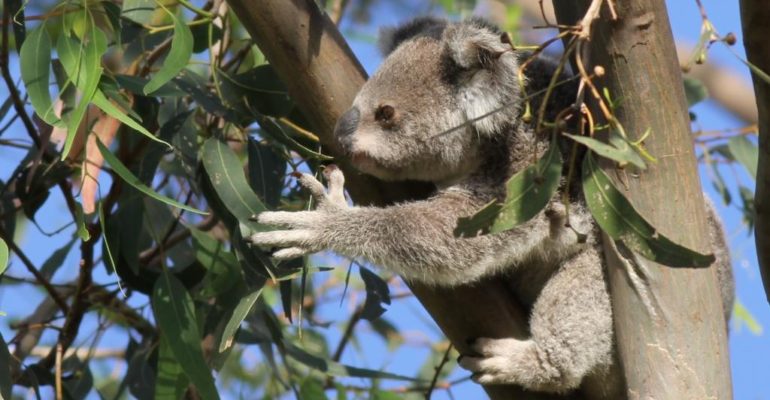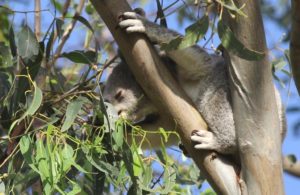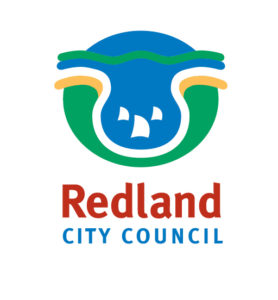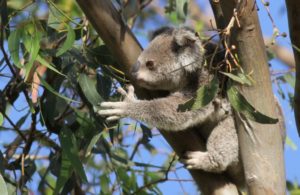

G20 Leaders in Brisbane 2014
G20 leaders cuddled koalas as part of “putting Brisbane on the map”. A great reminder of the value of koalas for tourism and the image of the Sunshine State.
Meanwhile, Redland City attracts world-wide attention from more than 30,000 people petitioning to stop removal of koala food trees in Ormiston.
The local newspaper says in an editorial that Redland City Council is not doing enough to halt the rapidly diminishing numbers of koalas in our city.
In response, the Mayor writes a letter to the newspaper saying that Council does what it can within the controls set out in State government legislation.
The State MP for Cleveland, however, tells concerned residents this is not a State Government problem. He says:
“it is the role of Council to assess development applications under the Sustainable Development ACT 2009″ and “this matter is solely one for the Council and the local Councillor”.
The State Government says in its bureaucratic way:
”the subject site does not contain regulated vegetation under the Vegetation Management Act 1999. Accordingly, the clearing of vegetation on this site is not considered a state interest matter in the case of this development application”.
So who is responsible for the plight of our koalas?
Even though koalas in Queensland are now classified as vulnerable under Federal environment law, the Federal Government washes its hands of responsibility for the Ormiston koalas. If a habitat reduction activity is deemed not “significant” the Federal Government says it is the “responsibility of State and local governments”.
We have been around the table and no one in government is prepared to put up their hand and accept responsibility for koala conservation.
We need a plan for koala conservation

Koala feeding
The science is clear. Koalas are heading to extinction due (mainly) to loss of koala “food” trees.
In the past 15 years the number of koalas in the Redlands has declined by 65%.
The Queensland Government acknowledges that: The biggest threat to koalas is habitat loss.
So how should we deal with this fundamental threat to survival of koalas?
Clearly we need all levels of government to take coordinated action, rather than shrugging shoulders and saying “its not my fault/problem/responsibility”.
All levels of government have a capacity to do much more for koalas.
We need a coordinated policy and planning framework that delivers certainty for koala survival.
Redland City Council’s role

The Council has planted many koala habitat trees on public land over a number of years including the term of the current Council. This is a good thing to do and it should continue.
Council has control of local laws governing vegetation management on private property. There is plenty of scope for reviewing these laws to provide more stringent protection of koala habitat. Council is aware of its ability to act in this way but appears to have done nothing. This is considered disgraceful neglect.
Council has spent much of this year preparing a draft new planning scheme which governs what can be built anywhere in the city. This planning scheme should be clearly based on objectives which include koala conservation. The community will be able to judge for itself how seriously the Council takes koala conservation when the draft City Plan 2015 is finally revealed for public consultation in the near future.
Finally, Redland City Council has an important role in making representations to other levels of government about the need for improved legislation, regulation and action to save koalas in the Redlands.
This could include arguing for:
- Improved mapping of koala habitat – if it is not measured, it can not be managed
- Inclusion of more stringent koala habitat provisions in the revised South East Queensland Regional Plan
- Ensuring that key environmental objectives are taken more seriously in the new Planning and Development Act
- meaningful offset provisions that ensure koala food trees are available to support koalas impacted by development i.e. now NOT in 10-15 years time!
To date we have no evidence that the current Redland City Council has lifted a phone, written a letter or made any formal submissions that would in any way improve the retention of koala habitat and help save koalas. However, there is evidence that the current mechanisms for protecting koalas have failed.
Queensland Government’s role

Queensland coat of arms with a red deer and a brolga
The koala is Queensland’s animal emblem. So what could the State government be actively doing to protect its emblem?
- Release up to date information about the number of koalas in south east Queensland.
- Ban clearing of koala habitat trees until proper conservation guidelines are in place.
- Amend the new Planning and Development Act to deliver protection for koalas and koala habitat in the face of urban development. Absolute protection, its simple!
- Ensure that all local government planning schemes recognize koala habitat as a “State Interest”
- Draft the new South East Queensland Regional Plan with a seriously impressive koala conservation objective.
Federal Government’s role

USA has a Bald Eagle Act to protect its emblem
Koala’s were classified as vulnerable under Federal environment law in May 2012. Draft guidelines were prepared for consultation and submissions closed on 7 February 2014. This was ten months ago. Since then nothing seems to have happened. Proper guidelines should be approved which provide koalas with significantly more protection than the inadequate draft guidelines. This should be attended to by Environment Minister Greg Hunt as a matter of urgency.
The Australian Koala Foundation is proposing that we have national koala legislation modeled on the USA’s Bald Eagle Act which has protected their national emblem since 1940.
The Australian Government should embrace and implement this idea to provide a high level “head of power” for koala protection in Australia.
Andrew Laming, the Federal Member for the Redlands, should step up and champion a national Koala Protection Act.
All together now

Everyone needs to lend a hand
We need a way of ensuring that all three levels of Government work together to deal effectively with issues like koala conservation. We want them to say “I can do this” instead of “Its not my problem”.
The community and all parties deserve and would be well served by certainty for koala protection. No one wins from the site by site battles such as we are witnessing at Ormiston.
A “joined up” and coherent policy and planning framework (involving State, local and Federal governments) is long overdue. After many false starts it is time to just do it!
One idea would be to change their remuneration arrangements so the elected politicians only get pay rises if they meet stipulated performance indicator targets which should include environmental objectives like maintaining net koala habitat at Year 2000 levels.
By the way, we would measure this by total volume of healthy habitat trees living, not the number of seedlings planted. Koalas know the difference between little seedlings and mature gum trees.
Further Reading:
Koalas safe at G20 vulnerable elsewhere by Debbie Pointing, of the Koala Action Group
Protecting koala trees in Redland City
Please note: Offensive or off-topic comments will be deleted. If offended by any published comment please email thereporter@redlands2030.net
One Comment
I believe if decisions are made by local or state government that kill our koalas (Wellington Street – Fitini development), should be made legally accountable with destruction of habitat. This is law both federally and universally acknowledged that purposeful destruction of habitat for any species is environmental vandalism. Why should any local/state/or federal government have the right to push any species to distinction. We still do not have enough knowledge about koalas and sub species will be lost before we know it. I am sick and tired of hearing about ‘offset’ plans. Do we just advise all species they have to wait 10-20 years for trees to mature and by the way you have to cross over several roads to get to existing habitat or a few trees that are left. Time to get legal I say and make everyone accountable for their decisions. How on earth can we increase the population in our region over 200,000 people and expect to have one koala left anywhere. Beautiful rich farmland is being lost and potential for wide wildlife corridors adding to the value of our region. How short sighted and money hungry.